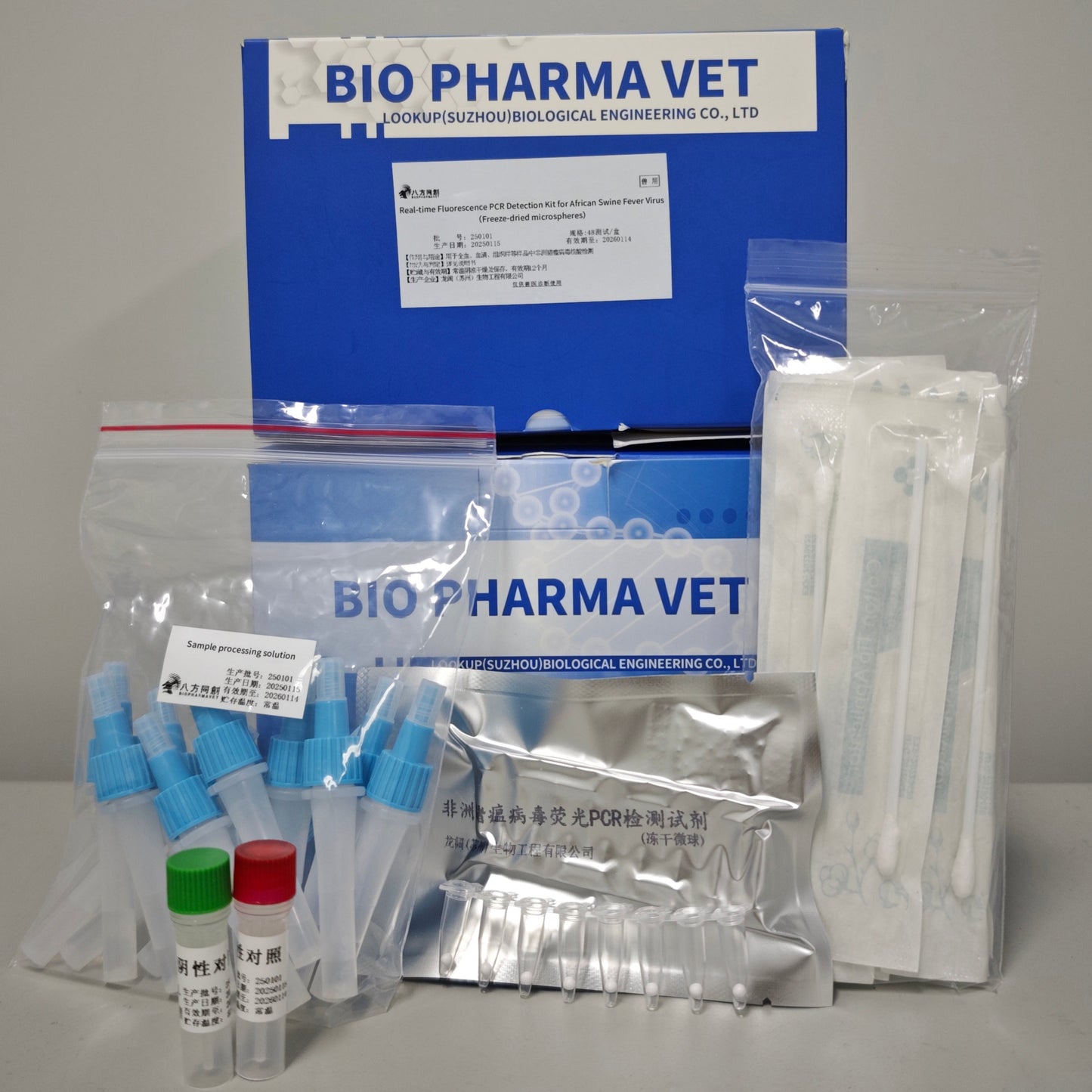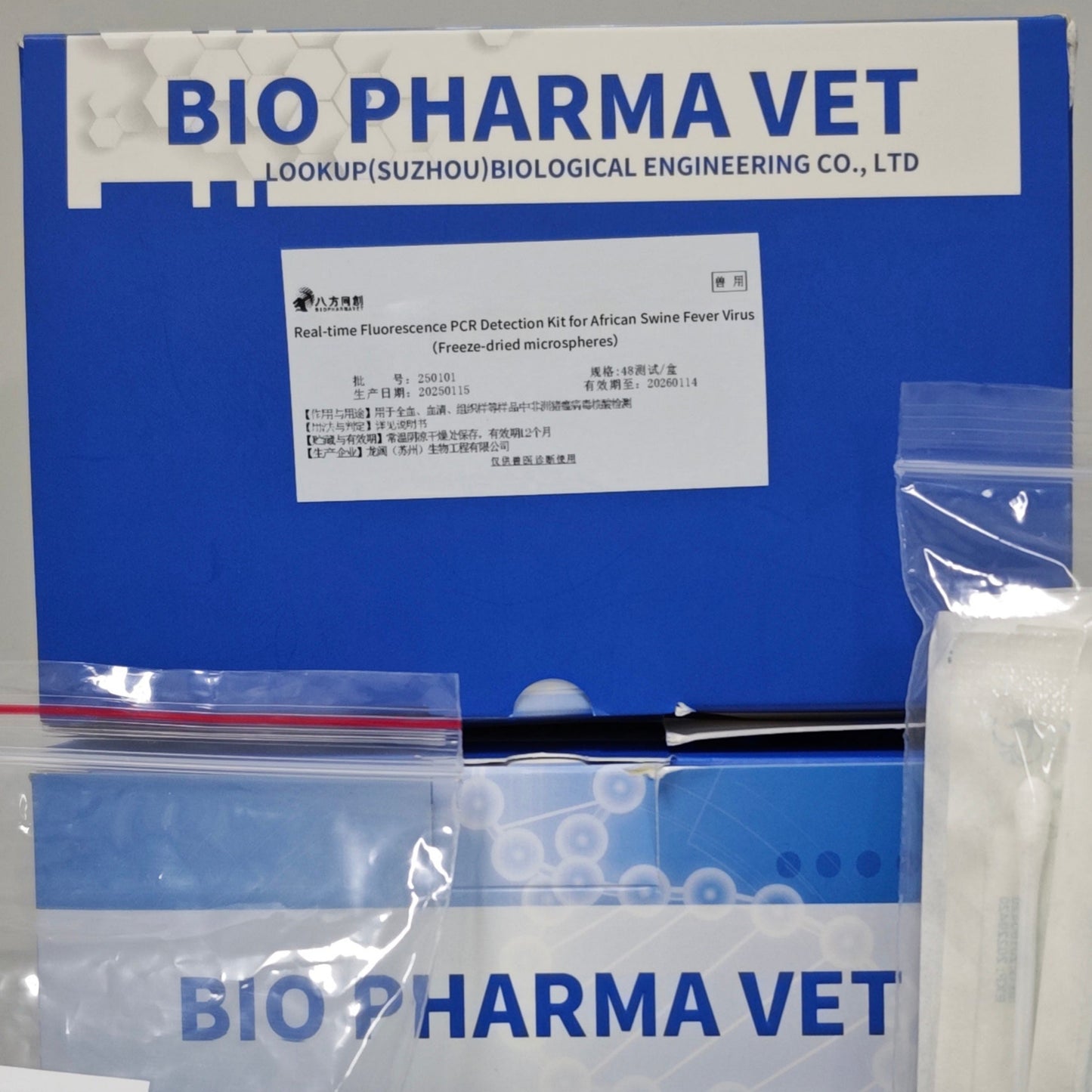Real-time Fluorescence PCR Detection kit for African Swine Fever Virus (Freeze-Dried Pellets)
Real-time Fluorescence PCR Detection kit for African Swine Fever Virus (Freeze-Dried Pellets)
Real-time Fluorescence PCR Detection kit for African Swine Fever Virus (Freeze-Dried Pellets) is used to detect the DNA of African swine fever virus (ASFV) in pig blood, serum, plasma, tissue and swab samples, and the test results can be used to assist the diagnosis of ASF virus infection.
Specification
Specification
48 Tests / box
Precautions
Precautions
- The test results of this kit are only a diagnostic aid. Please read this manual carefully before use.
- This kit is suitable for ASFV virus detection only.
- Before the experiment, please be familiar with and master the operation methods and matters needing attention of various instruments.
Storage
Storage
The reagent should be stored in the dark and sealed at ambient temperature.
Validity Period
Validity Period
The shelf life of the kit is 12 months.


Product Information(Real-time fluorescence PCR detection kit for African swine fever virus)
This product is for scientific research purposes. It contains reaction buffer, DNA polymerase, UDG enzyme, lyophilization protectant, and primer-probe components. The reaction buffer contains essential components for amplification, such as Mg2+ and dNTP. This product is in lyophilized formulation.
| Reagent Name | Specification and Loading |
| Real-time fluorescence PCR detection reagent for African swine fever virus (freeze-dried micropellets) | 8 tests / bar, 1 bar / 1 box |
| negative control | 100 μ L / tube, 1 tube / box |
| positive control | 100 μ L / tube, 1 tube / box |
| Sample treatment solution | 400 μ L / tube, 8 tubes / box |
Remarks:
- The components of different batch numbers of products may not be mixed or exchanged.
- The biological samples in the kit have been inactivated.
- Equipment and reagents required for the test: centrifuge; fluorescence quantitative PCR system (BIO-mini); paraffin oil.
Sample Requirements
- Applicable sample types: spleen, tonsil, lymph nodes, kidney, muscle, serum, plasma, whole blood, swab, etc.
- Sample pretreatment:
- Tissue sample: Place about 100mg of tissue into the grinding appliance, add about 1 mL of sterile saline, fully grind and homogenate, transfer the tissue suspension to a sterile centrifuge tube, centrifuge at 3000rpm for 2min, and take the upper liquid for use.
- Serum, plasma and whole blood: stored without pretreatment.
- Swabbing: Prepare sterilized 1.5 mL centrifuge tube, add 1 mL sterilized saline, place the sample swab into the tube, break the swab bar, cover, mark, after shake, take the soaking solution before use.
Method of Calibration
- Sample processing: Dip in the appropriate amount of the sample with a cotton swab, put it into the sample release agent, rotate and mix well, to ensure that the sample nucleic acid is fully cracked in the sample release agent.
- Reagent preparation: Calculate the number of reaction tubes N for real-time fluorescence PCR detection kit (lyophilized micropellets) (N= number of samples to be tested)
3. Sample sample
3.1 25 μ L of processed samples shall be added to the real-time fluorescence PCR detection reagent containing African swine fever virus (lyophilized microspheres) reaction tubes.
3.2 20 μ L of paraffin oil was added to all reaction tubes.
4. PCR amplification
4.1 Place the reaction tube into the PCR instrument sample tank.
4.2 Instrument parameter setting: 1) Select FAM channel for ASFV-DNA; 2) Select ROX channel for internal standard.
4.3 Setting of the cycle parameters
| procedure | conventional program | |||
| temperature | time | recurring number | ||
| 1 | UNG, enzyme reaction | 37℃ | 120s | 1 |
| 2 | Taq, Enzyme activation | 95℃ | 180s | 1 |
| 3 | denaturation | 95℃ | 10s | 45 |
| Annealing, extension, read light delay: 26s | 60℃ | 30s | ||
| 4 | Instrument cooling | 25℃ | 10s | 1 |
After setting it up, you will run the reaction program.
5. Quality control
5.1 ASFV-negative control: No Ct value is shown in the FAM channel, and the Ct value in the ROX channel is ≤30.
5.2 ASFV-Positive control: Ct values for both FAM and ROX channels.
5.3 The above requirements should be met in the same experiment at the same time, otherwise, this experiment is invalid and needs to be carried out again.
6. The result is determined
6.1 The Ct value of ROX channel is 30 and the amplification curve is typical S type, according to "6.2~6.3";
6.2 The Ct value of FAM channel 45 and the amplification curve is typical of S type, reported as positive for ASFV nucleic acid;
6.3 FAM channels without Ct values or typical S type amplification curves were reported as ASFV nucleic acid negative.


